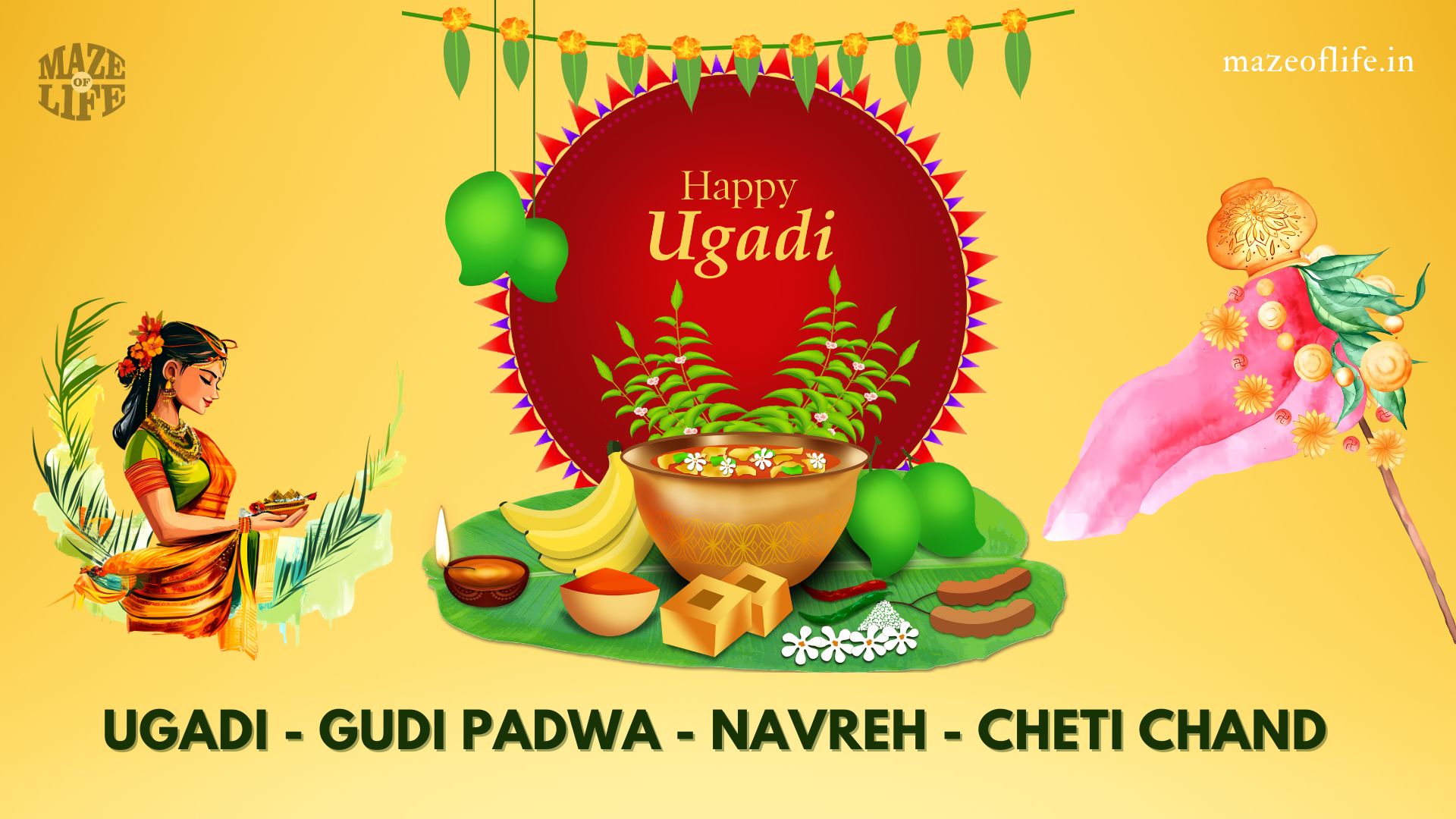The coming of a new year is always a special occasion, and in India, various parts of the country celebrate it differently. The first day of Chaitra month is the start of the Hindu lunisolar calendar, and numerous communities celebrate this day as their New Year. In Andhra Pradesh, Telangana and Karnataka, we call it Ugadi. In Maharashtra and Goa, it was celebrated as Gudi Padwa. Chaitra Shukladi in the North and Navreh in Kashmir. Every festival has its own set of traditions, but they all have the spirit of new beginnings, thankfulness, and happiness.
Let me walk you through some of these lovely festivals.
Ugadi – A New Beginning in South India
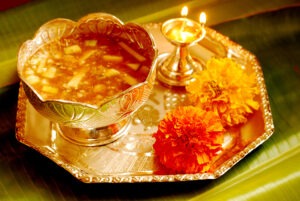
I have always enjoyed how Ugadi is celebrated in Andhra Pradesh, Telangana, and Karnataka. Its very name is the beginning of a new age. Houses are cleaned and festooned with mango leaves and rangoli with colours on this day.
One of the best things about Ugadi is the tasty festive cuisine cooked on this day. All houses are filled with the smell of special cuisine. The most significant of them is Ugadi Pachadi, a special dish of six different tastes:
– Jaggery (Sweet) – Denoting happiness
– Tamarind (Sour) – Denoting hardships of life
– Neem flowers (Bitter) – Symbolising struggles and hardships
– Raw mango (Tangy) – Indicating surprises and excitement
– Chili (Spicy) – Showing anger or feelings
– Salt (Salty) – Portraying the necessities of life
I adore what this dish symbolizes – we are reminded that life consists of various things, and we need to take them all with balance.
Besides Ugadi Pachadi, there are a few of their most sought-after dishes:
– Pulihora (Tamarind Rice) – A tasty, slightly sour dish prepared with tamarind and rice
– Bobbatlu / Obbattu / Puran Poli – Sweet stuffed flatbread prepared using chana dal and jaggery
– Mango Rice – Seasonal dish prepared with raw mangoes, giving a fresh, sour flavor
– Payasam / Kheer – A sweet pudding of rice, jaggery, and milk
Families sit down to have these meals after praying at temples and hearing the Panchanga Sravanam, which provides forecasts for the coming year.
Gudi Padwa – The Maharashtrian New Year
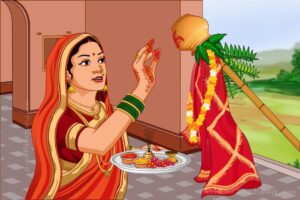
In Maharashtra and Goa, the New Year is referred to as Gudi Padwa. I always wonder at the sight of the Gudi (a decorated flag or banner). It is prepared by tying a colorful silk cloth on a bamboo stick, along with neem leaves and a garland, and covering it with a silver or copper pot. The Gudi is raised outside houses, generally on the right side of the main door.
The Gudi is a symbol of victory, prosperity, and protection. Some consider that it symbolizes the flag of Lord Rama’s victory return to Ayodhya when he defeated Ravana. Some others consider it as a symbol of Shivaji Maharaj’s victories*. Many also think that gazing upon the Gudi in the morning will bring good fortune for the rest of the year.
Families rise early, have a sacred bath, and adorn their homes with rangoli. Traditional sweets such as Puran Poli and Shrikhand are prepared, filling the festive atmosphere.
Chaitra Sukladi – North India’s New Year
In most of the central and North India, the people celebrate the Hindu New Year is as Chaitra Sukladi, the beginning of the Vikram Samvat calendar, founded by the mythological king Vikramaditya. It is a significant day in areas such as Uttar Pradesh, Madhya Pradesh, Rajasthan, Bihar, and Delhi.
On this day, individuals rise early and go for a sacred dip in holy rivers such as the Ganga and Yamuna, as they think it cleanses them of their sins and bestows good luck. Numerous individuals go to temples and pray to gods, particularly Lord Vishnu and Goddess Durga. The day also ushers in Chaitra Navratri, a nine-day festival in honor of Goddess Durga.
I adore how today promotes reflection and new beginnings. One reads from the Panchang (Hindu almanac), organizes auspicious rituals for the entire year, and takes blessings for good health and prosperity. The north Indians prepare special meals such as Kheer, Puri, and Halwa, so the festivity becomes all the more pleasant.
Navreh – Kashmiri New Year with Holy Customs
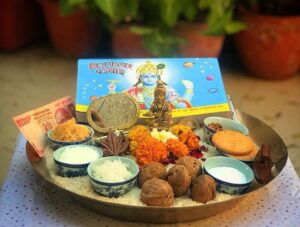
The Kashmiri Pandits in Kashmir, celebrate New Year as Navreh, i.e. New Day. It is intensely related to spirituality and nature. They celebrate the festival a night in advance with a special Thali (platter). This holy platter includes:
– Rice (for good fortune)
– Flowers (for beauty and joy)
– Coins (for prosperity and achievements)
– A mirror (for self-reflection)
– A holy almanac (to know what the next year will be like)
In the early morning hours, members of the family rise and examine the Navreh Thali immediately, believing it to be an auspicious way to begin the next year. Following this tradition, individuals visit temples, say prayers, and recite the Bhagavad Gita or other holy scriptures.
Numerous Kashmiri Pandits also make pilgrimages to Goddess Sharika’s shrine at Hari Parbat, praying for wisdom and power. The Kashmiris mark this festival with traditional cuisine, music, and narration, sustaining the rich culture of Kashmir.
Cheti Chand – The Sindhi New Year
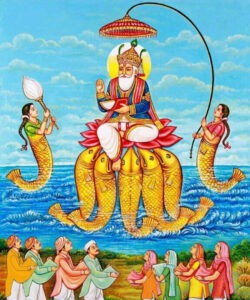
The Sindhis celebrate this New Year as Cheti Chand. It is also the birthday of Jhulelal, their patron saint. I appreciate how the Sindhis celebrate this festival with dignified processions, devotional songs, and prayers by rivers or lakes.
They exchange Jhule Jhule Lal! greetings, expressing gratitude and asking for blessings for a fruitful year. The Sindhis prepare special meals, and the whole community unites in a spirit of joy and devotion.
A Common Thread of Hope and Celebration
Even though these festivals have different names and traditions, they all celebrate the same idea – a fresh start, gratitude, and hope for the future. Whether it’s tasting Ugadi Pachadi, hoisting the Gudi, looking at the Navreh Thali, or singing Jhulelal bhajans, each custom connects us to our roots and reminds us of the richness of our culture.
For me, these festivals are not merely rituals but about family, togetherness, and excitement of new beginnings. Do you get to celebrate any of these festivals? I would really love to hear from you! ????
For other interesting posts please visit Maze of Life.


